No one brand has impacted more audiophiles in their early years than NAD. For my fourteenth birthday, my Dad generously bought me a Nakamichi Music Bank CD changer, a pretty sweet NAD receiver, a pair of Polk floorstanding speakers, and some classic Monster Cable to connect it all. Much like many of my reviewers around that era, I was hooked on audio from that moment on. In the years/decades following that, I have been blessed enough to own pretty much every other brand of high-end audio component and dozens more ultra-cool audiophile speakers. I think Nancy Reagan said it best when she called NAD components the audiophile “gateway drug,” and no, none of us “said No” to NAD, because the value was what we needed, and the performance delivered above its asking price.
The NAD M10 V3 integrated amp, priced at $2,499, is a diminutive component that has a feature list that reads like an audiophile’s dream come true. This little sucker delivers everything from a modern Class-D amp to a BlueSound Node, basically right in the chassis, to HDMI for eARC to Dirac LE room correction (with mic included and an upgrade path for $99 for full Dirac Live aka: full-range room correction – not just bass) and much, much more. There are other quality, all-in-one audiophile integrated amps on the market today (think: just add speaker-type components), but few take on this challenge with knives this professionally sharpened. The audiophile community holds NAD’s Master Series products to a very high standard in terms of performance, while never allowing them the budget that other brands demand. Can the NAD M10 V3 integrated amp live up to that unrealistic and seemingly unreasonable challenge? Let’s find out.
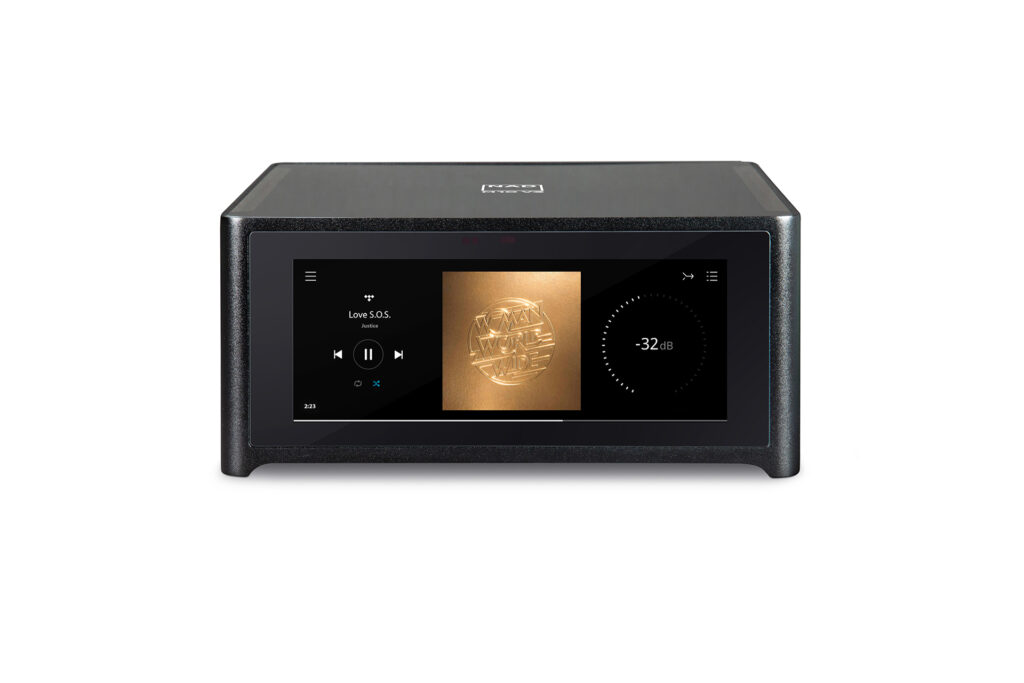
What Makes the NAD M10 V3 Integrated Amp Special?
- How can 100 watts (160 when pushed to maximum measured output) of real-world power come from such a small audiophile integrated amp? NAD’s NCore Amplifier technology delivers on that promise with high-current power for nearly any modern speaker that you might want to drive anywhere near this price point. If you need more power, you can add that (as I did back in my teenaged years, as I started first growing my early audiophile system) by using the preamp outputs that are found on most good integrated amps, thus leaving a reasonable upgrade path for many of us. There are many external, standalone audiophile amps that can deliver more/better/different power and that can be part of one’s upgrade path without question.
- The biggest rave review that I can remember writing in the past 10 years is of the BlueSound Node 2024 music streamer that comes with Dirac digital room correction. That sucker is basically included inside this little audiophile powerhouse. And while you can (and I did) control the NAD M10 V3 integrated amp with your phone or iPad (I prefer iPad, as I don’t want to be that much of a slave to my iPhone when at home), you can also access your music right on the gorgeous LED screen on the front of the unit.
- Touching on upgrade paths and other thoughtful, features, the NAD M10 V3 also has digital inputs and multiple subwoofer outputs. That isn’t always found on other, comparably-priced integrated amps no matter what brand(s) the audiophile retailer sells.
- So many features have been thought of and delivered on. Apple Airplay 2, Spotify Connect and Tidal Connect come to mind in terms of the streaming options. That covers most bases for streaming but, then again, the BlueSound Node (I am counting the internal streamer as one) already has most streaming bases covered, with many able to do HD sources.
- Speaking of HD sources, the NAD M10 V3 integrated amp comes packing the always popular and high-performance 32-bit ESS Sabre chip-based internal DAC, which is not that different than the one that we loved in the award-winning Chi-Fi Topping D90 III Sabre (read the Topping DAC review, or learn about Chi-Fi in these two provided links)standalone $899 DAC.
- For those who want to get even more advanced with their streaming (really?), you can use Roon and the NAD M10 V3 integrated amp. The NAD M10 V3 also supports the now-Lenbrook-owned MQA music file format. I got a chance to try out all of the cool features of Roon that Brian Kahn talked about in his article/guide on the Roon Service (read about that here). I agree with Brian on the power of Roon’s meta data management, which is nothing short of great. The limited number of streaming partners/services (as compared to BluOS) was my big issue with Roon, as was the need for some form of external “core” processor for many non-NAD-M10 users. A $15 per month fee for the software kind of bummed me out about the platform, but overall, I liked Roon. Simply put, you will never need Roon, because of the internal Node-like streamer, but you’ve got that option if you like. On a different front, MQA was an interesting pickup by NAD’s parent company, but I am not sure what you do with those files at this point, unless you already somehow bought in to that now seemingly dead audiophile format. Lenbrook might find a way to revive it, but for now, I am not seeing the big value with MQA. Still, the NAD M10 V3 integrated amp has it, just in case.
- Most integrated amps don’t have many inputs, but the NAD M10 V3 has unbalanced analog in, inputs for a moving magnet phonostage, and coax and optical digital inputs. This means that, for people consolidating their audiophile lives down to a simpler setup but who have some legacy source components (think: an audiophile turntable, a silver disc player, or even something crazy, like a VCR or a cassette deck), they can make them work easily with the NAD M10 V3 integrated amp.
- Dirac Live can be configured with the NAD M10 V3, which is one of the best digital room correction options in the market today. This requires a microphone for calibration (included), as well as a fee of $99 for the full Dirac Live experience which means full-range room correction – just just in the bass. For $99, that’s an excellent idea and value.
- BluOS thoughtfully allows for multi-room connections. This allows you to use an NAD M10 V3 more like a Sonos product, thus networking it with other components in your NAD world to make a whole-home music playback system.
- Speaking of whole-home audio, the NAD M10 V3 comes loaded and ready for bear with home automation systems/platforms, like Crestron, Control4, and a whole slew of other ones like RTI, Universal Remote Control (URC), Lutron and iPort.
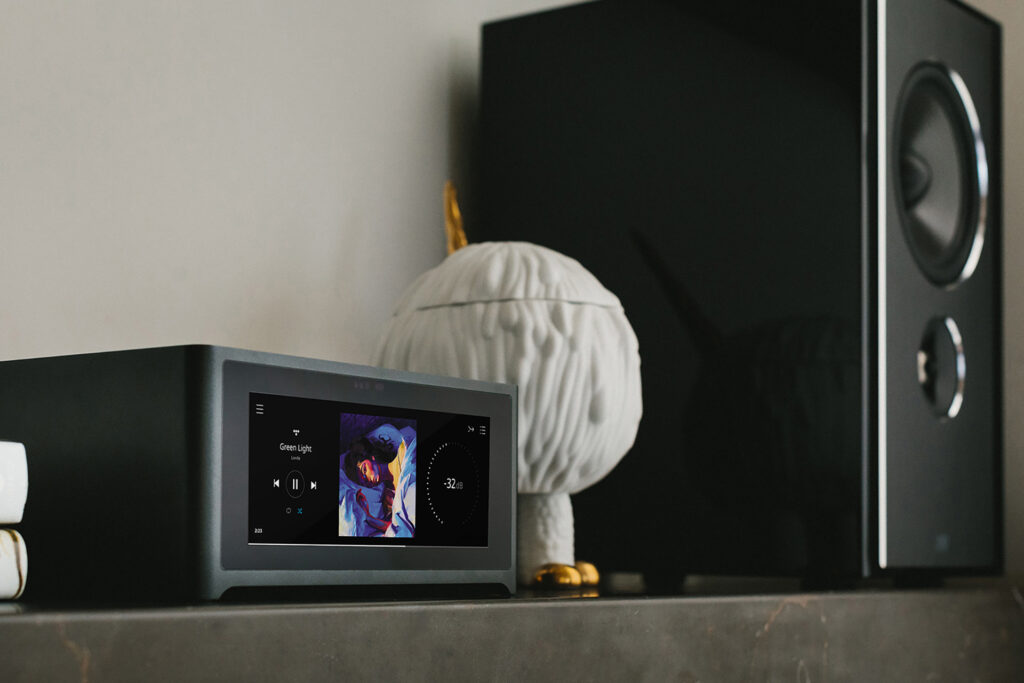
Why Should You Care About the NAD M10 V3 Integrated Amp?
Less is more, right? The NAD M10 V3 delivers more features in a less bulky component and, for those who are looking to consolidate their systems, this $2,499 component pretty much answers all of the questions for the more advanced audiophile who wants less complexity in their system in an often overly complicated technological world.
For the audio enthusiasts on the way up in the hobby, this is an all-in-one solution that gets you nearly every audiophile feature known to man, paired with so many other thoughtful, more mainstream tech features and connectivity options. The NAD M10 V3 integrated amp does pretty much everything that you can dream of in a small, well-crafted chassis.
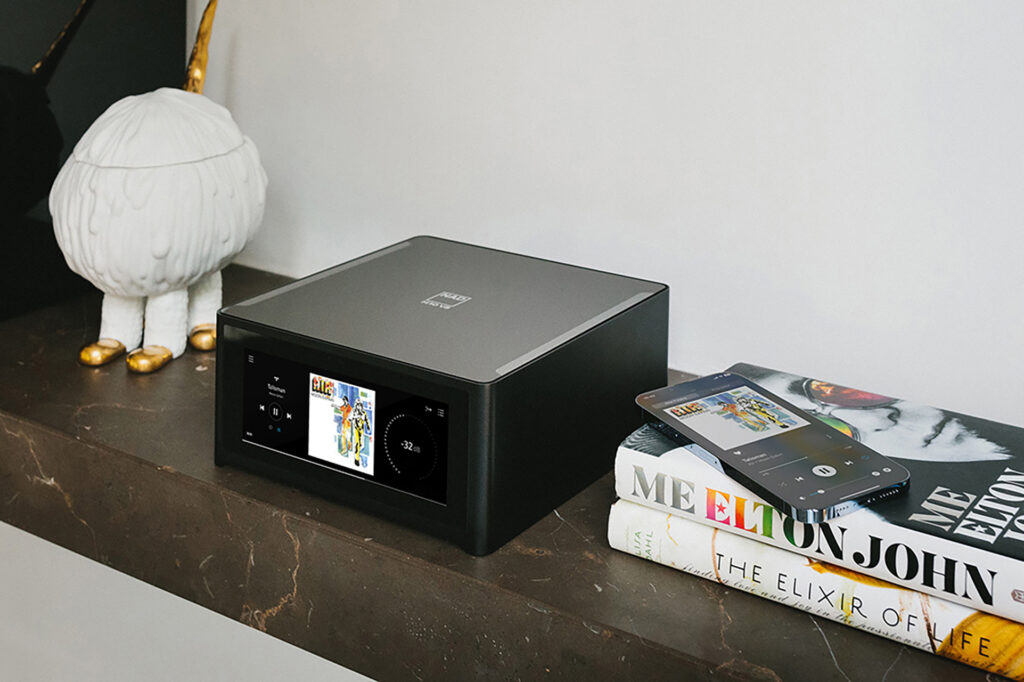
Some Things You Might Not Like About the NAD M10 V3 Integrated Amp
- Integrated amps are tougher to upgrade from than non-combined audiophile components. For the audiophile making moves to get the most from his or her system, it can be tricky to upgrade when getting into an integrated component like the NAD M10 V3, versus separate components. The simplicity of having all of your audiophile functionality in one place is tempting, but if you want to upgrade your DAC, you need to come into the NAD M10 V3 analog (which you absolutely can do). The issue with the NAD M10 V3 is more about using the value of any one of the integrated features into a new component, in that you can’t sell off the streamer inside of the NAD M10 V3 to get a fancier one, but you could use a fancier one and send it in via digital COAX or optical connection or an unbalanced RCA connection. You just can’t pocket the money that you invested, thus the slight downside that comes with any integrated audiophile solution like this today.
- The remote on the NAD M10 V3 is somewhat limited, and I can see why, as this saves money that can be allocated from the design budget into other, more important features in a mid-priced integrated amp. An iPad or smartphone is a better way to control this complex unit, but for simple tasks, the simple remote is suitable. I almost always used an iPad or just the front LED screen on the NAD M10 V3.
Listening to the NAD M10 V3 Integrated Amp …
All of my listening was done on high-end Bowers & Wilkins speakers, including the $8,500 Bowers & Wilkins 805 D4 speakers (read Greg Handy’s review), as well as my reference Bowers & Wilkins 802 D4s (read my review here) which are priced at a heftier $28,000 per pair. Even on more demanding music, and considering that Bowers 800 Series speakers come in around 90 dB efficient, the NAD M10 didn’t really flinch, even when smacked with a big demand for current during musical peaks.
On “Run Like Hell” from Pink Floyd’s epic Roger Waters’ life story musical biography, The Wall (QoBuz), with the NAD M10 V3 powering the larger and somewhat more power-hungry Bowers & Wilkins 802 D4s, I was impressed with the heft and detail that I could hear on the bass guitar. With no audiophile subwoofer in my rig, I heard that visceral impact that I like from this musically energetic track. The synthed-out David Gilmour guitar effects sound cool as you get into to the song, but the detail on the decayed and chorused guitars was of specific note, in that they can sound thin or bright on older Bowers & Wilkins, and/or when playing them back on lesser electronics. I loved the detail that I could hear. There were little drum or percussive fills, back in the mix at around the 3:00 mark of “Run Like Hell.” These fills are easier to hear about 20 seconds later because of the mix of the song, but the NAD M10 V3 delivered both suitable power and remarkable detail, considering its price, in ways that could light up speakers that are used to being fed from far more expensive electronics.
Getting a little jazzy, I cued up “Totem Pole (alternative take)” from Lee Morgan’s The Sidewinder (QoBuz) and, from the first note piano notes (playing through the Bowers & Wilkins 805 D4s this time), I was taken aback a bit by the level of depth that I could hear in the Rudy Van Gelder mix. Most feature-laden integrated amps deliver on the features offered, but can tend to sound one-dimensional or flat. Not the NAD M10 V3 integrated amp. You hear vibrancy on the piano tones. There is air around the horns as they dance above the more percussive piano, drums and bass in the first verse. We were making some really good sound on some really good speakers in ways that represent the type of audiophile performance that I think one should expect from gear costing significantly more.
I will go out on a limb and say that the best audiophile demo that I’ve ever heard from the blues genre is the all-time classic “Mannish Boy” from Muddy Waters’ Hard Again (learn more from the Wikipedia page about the album). Mark Levinson’s 1990s recordings of the last remaining blues legends is more acoustical and wonderfully recorded by my college mentor, but this more dynamic and electric recording (including Johnny Winter on guitar) should be on everyone’s saved tracks list for best audiophile demos. What struck me when listening to the Bowers & Wilkins 805s again was the space and depth that you could hear when powering $8,500 speakers with a $2,500 integrated amp. Muddy Waters’ voice is placed dead center, with a demanding, vibrant and compelling sonic effect. What you can really dig into are the fine details of the recording, as there are all sorts of people in the background yelling and screaming in seemingly religiously-charged yelps and enthusiastic outbursts in this “recorded live” track. The reverb on Winter’s guitar sounds tangy, vibrant and alive in the mix, but never, ever overpowers the star, which is Muddy Waters.
Will the NAD M10 V3 Integrated Amp Hold Its Value?
I don’t foresee many people who buy an NAD M10 V3 integrated amp selling them, mainly because even if you started with one early in your audiophile journey, you will likely want to keep this small but feature-laden and sonically capable component for another system in your living situation.
In the event that you did sell an NAD M10 V3, you likely will do well on it, as it has so many unique features, paired with compelling input and output options, that somebody somewhere is likely to want to use this component somewhere in their audiophile lives. NAD does suitable marketing and the brand gear, (especially the Master Series), thus is known in the enthusiast community for both performance and value. Simply put, you will never get hurt too badly if you were to invest in an NAD M10 V3 integrated amp, as this small and easy-to-ship audiophile component delivers so well on so many fronts that it will always have a strong appeal to many audiophiles.
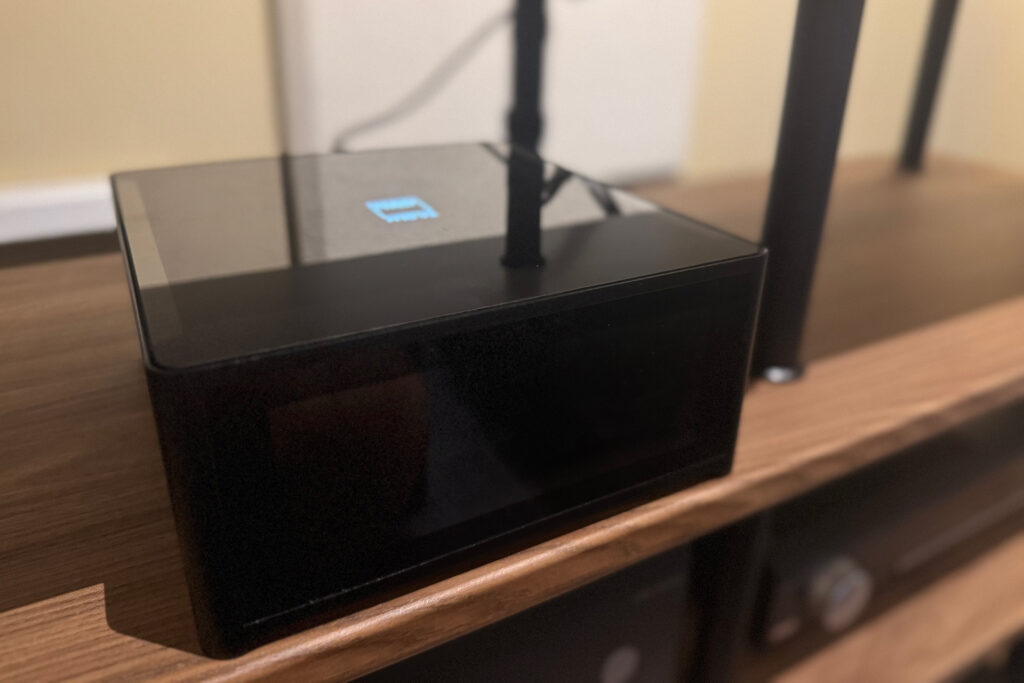
What Is the Competition for the NAD M10 V3 Integrated Amp?
The recently-reviewed HIFI ROSE RA280 integrated amp (read Andrew Dewhirst’s review) at $2,995 is a good place to start, and a worthy competitor. The HIFI Rose is built better and looks sexier, but it doesn’t even remotely come close to the NAD M10 V3 in terms of overall features. Sonically, the HIFI Rose benefits from a GaN (Gallium Nitride – learn more from this article)amplifier section, which delivers in a different way (that we rave about in other products like Orchard Audio power amps) that Class-A or “tube-like” sound without any of the heat, biasing or other grief historically associated with tube amps in the past. The somewhat steampunk industrial design of the HIFI Rose gear is much sexier than the “dressed in black” simplicity of the NAD M10 V3.
Another big-boy competitor for a lot more money and with a lot more power is the recently-reviewed Anthem STR Integrated Amp at $4,995 (buy at Crutchfield or read the Anthem STR Integrated review here). This full-sized unit gets a nod in the comparison section, in that it is the merger of one of my reference components, the Anthem STR preamp, with a big-ass, internal Anthem power amp, all in the same component. The Anthem has ARC room correction, which is a rare feature in an integrated amp. The Anthem has more power and delivers more sonic heft, or headroom, if you will. And it should, as this big-bad audiophile integrated amp is twice the price, much larger and much more powerful than the NAD M10 V3. The Anthem’s room correction is also functional, versus the NAD, which is “coming soon to an integrated amp (or BlueSound streamer) near you.”
NAD has their own competitor for the Master Series M10 V3 integrated in the NAD C700 V2 integrated amp at $1,599 (buy at Crutchfield). You get a little bit less power (80 watts vs 100), and a lesser DAC, but you still get the streamer, BluOS, (pending) room correction and many of the benefits of the NAD M10 V3 Master Series product for less money. For those on a budget, you get a good bit of what we love about the M10 V2 from a less expensive but still very thoughtful NAD audiophile integrated amp.
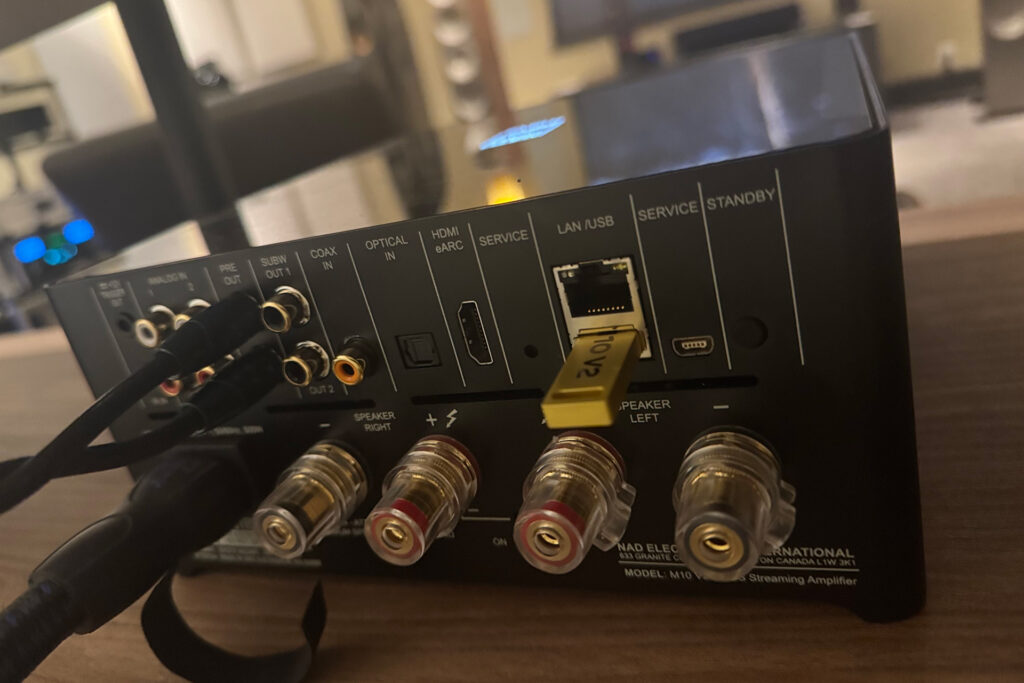
Final Thoughts on the NAD M10 V3 Audiophile Integrated Amp …
I am currently mentoring a Generation Z college student, who is a junior studying at the State University of New York at Binghamton. Not only is this city where the legendary McIntosh brand hails from, but Binghamton is a total secret-value school that so many of my friends attended years ago. Many of them went on to get MBAs from places like Columbia, or Masters in Education from Harvard. It is safe to say that Binghamton is a smart way to put yourself on the track to higher education (Ivy League-style), but without blowing out $100,000 per year like at my alma mater, USC (so expensive, but really good/fun).
The NAD M10 reminds me of that same tempting value proposition. Are there better schools than Binghamton? Perhaps, but at what cost? A much higher price (my buddy looked at potentially going to Michigan, a top 25 school with a strong football program, and it was over $80,000 per year for an undergraduate degree), and not always a better value. The NAD M10 V3 integrated amp wouldn’t just be a crushingly good place for my main man to start his audiophile journey but, at its price, it also is an excellent value.
Simply put, you can’t find a more complete feature set than that of the NAD M10 V3 integrated amp, it is a high-end player at a reasonable, aspirational price. For $2,499, I successfully powered up $8,500 bookshelf speakers, as well as reference-level, A-List floorstanding speakers, like the $28,000 Bowers & Wilkins 802 D4s – both used in the some of the best studios and mastering labs in the world. And I did that with a $2,499 integrated? Yes, I did (and you should too), as the NAD M10 V3 integrated amp is up to that lofty of an audiophile challenge, and much more.




Hi Jerry, great write up on a very capable integrated amp. If you’re really interested in full frequency room correction in a comparably priced integrated amp, I recommend the Lyngdorf 1120. Amazingly capable technology that really helps performance at home, on top of a full featured integrated amp.
Keep up the great work.
Thanks for the thoughtful review. Like you, I had a great experience with NAD early in my audio continuum and have a positive impression of them as good performance-for-value. It looks like a nice unit.
Reading the review, I found this phrase hard to understand:
“Mark Levinson’s 1990s recordings of the last remaining blues legends is more acoustical and wonderfully recorded by my college mentor…”.
1. I think you are saying that ML was your college mentor, but it’s hard to decipher.
2. It seems that you are referencing recordings of Muddy Waters made by ML in the 1990s. MW died in 1983.
3. Possibly you mean remixes or remasters by ML.
4. The wording (“… recordings of the last remaining blues legends …”) suggests that there may be a series of recordings by others in addition to MW done by ML. Or maybe it’s a typo.
I’m not trying to be picky or snarky here. If there are high quality recordings of Muddy Waters or other blues artists engineered or produced by Mark Levinson, I am genuinely interested. I looked on Discogs and AllMusic but couldn’t find anything. If you can point me in the right direction I’d appreciate it.
The M10 has been a homerun for NAD, and a TON of audiophiles have either heard or owned one in the last six years. Which makes a review without a comparison to previous generations frustratingly incomplete.
I understand you can’t review every piece of gear in the context of its predecessor. But the M10 is enormously popular and a common reference point for many. I’m not saying it’s quite as legendary as the KEF LS50, but not far off. And how many LS50 Meta reviews didn’t reference the earlier LS50, if not subjectively than at least in comparing specs? I’d venture to say close to zero.
I think the only new feature on the v3 is the addition of the phono stage … but I’m honestly not sure. And it would’ve been nice if you, the reviewer, had at least done that much for me, the reader. (I’m not saying that just as a previous M10 v1 owner. If a newcomer, excited after reading your review, were to learn that the v2 is spec’d the same as v3 other than a phono stage, there’s a good chance they’d seek out a v2 for less money.)
I really do appreciate you taking the time to listen to the v3 and write up your thoughts (I even like your test tracks!) But there is a large audience of v1 and v2 owners who clicked on your article in hopes of answering the question of what’s new and should they upgrade. Unfortunately, you gave them no relevant information.
You know, you’re quickly on your way to becoming my replacement to Stereophile’s former “Audio Cheapskates” Sam Tellig and Corey Greenberg. Their obvious replacements, so to speak, come from these sundry YouTube reviewers, but I remain suspicious of most of them as they seem to like literally everything they review and parrot the same basic talking points while using the same cliched buzzwords.
But I digress . . . . so thanks to this review I’ll now have to reconsider whether to go with NAD’s C399 or perhaps consider this one instead. One thing’s for sure, with the introduction of their Master’s Series roughly 20 years ago, NAD is no longer merely the entry ticket into audiophilia and nothing more. If a $1,000 NAD “Classic Series” component can bring you very close to the performance of a boutique brand’s $10,000 component, then a $5,000 Masters Series get up should perform likewise when put up against these cost-no-object $50,000 systems. I started with NAD, jumped on board the endless upgrade train, and have returned to NAD now that common sense has returned and my priorities have matured.